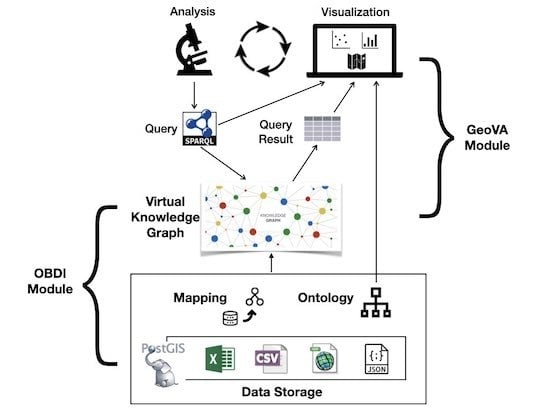A Framework Uniting Ontology-Based Geodata Integration and Geovisual Analytics
Abstract
:1. Introduction
2. Background and Related Work
2.1. Ontology-Based Geospatial Data Integration
2.2. Geovisual Analytics
2.3. Sensor Data Analysis
3. GOdIVA: A Framework Unifying Ontology-based Geodata Integration and Visual Analytics
3.1. Ontology-Based Geodata Integration Module
3.2. Geovisual Analytics Module
4. Case Study
4.1. Test Area and Data
4.2. Ontology-Based Data Integration
4.2.1. Ontology
- We have created two classes :WeatherStation and :TrafficStation as subclasses of both sosa:Platform and geo:Feature.
- We have created five subclasses of sosa:Sensor, e.g.,:MinTemperatureSensor and :TrafficSpeedSensor.
- We have created five instances of the sosa:ObservableProperty class, e.g., <minTemperature> and <trafficSpeed>.
- We have introduced a class :GridCell extending geo:Feature to represent a seamless partition of a geographic area. Then we create the :Interpolator class as a subclass of ssn:System, whose instance is hosted on a :GridCell platform and interpolates instances of :Observation.
4.2.2. Mapping
|
<traffic_station/3> a sosa:Platform . <traffic_volume_sensor/{station_code}/dailyTrafficVolume> a sosa:Sensor . |
4.2.3. Query
4.3. Geovisual Analytics
- A data access and analysis view (upper left). This view lists the core concepts as information items, which connects the ontology model and SPARQL. Users can click/check the intended features to formulate a query to access data. The design of this view is basically according to the core vocabularies in the ontology, including stations, sensors, and observable properties. A time window is added to select data in a certain time slot. In addition, we add one functionality to allow the visual exploration of the correlations between weather and traffic data. At the moment, the view is hand-crafted, but we plan to automatically generate it in the future according to the ontology.
- A SPARQL query view (bottom left). This view is linked to the data access view. When the query is formulated and issued to the SPARQL endpoint, it draws a network graph of the SPARQL query, showing directly the basic graph patterns of the query. It allows an intuitive perception of the involved concepts and their complicated relations.
- A map view (upper right). The map view is linked with the data access view and the statistical view. It is designed to show the spatial distribution of queried objects, for instance, the locations of all the meteo-stations, and the precipitation distribution. In addition, users can interactively select a feature on the map to investigate its characteristics in the linked statistical view.
- A statistical result view (bottom right). It is linked to the data access view and the map view, and is designed to show relevant statistics of the selected feature on the map in the selected time period. We have designed three tabs, respectively showing the basic information of the selected feature (e.g., traffic station ID, and the min and max traffic volume at this station), the time series of the observations, and the correlation coefficients of the weather and traffic at this station.
- Network visualization. The visualization consists of nodes and edges and is especially suitable to visualize the complicated objects and relations involved in SPARQL queries. Figure 6 shows the query graph after selecting the traffic station with the ID of 3 to retrieve all the relevant information of this station, in which blue-filled nodes are used to represent IRIs and literals, and unfilled ones are variables.
- Dot maps and Heat maps. Cartographic techniques are effective in conveying spatiotemporal patterns. We use dot maps to represent the distribution of the sensor and station locations, and heat maps to show the distribution surfaces of the continuous phenomena, e.g., precipitation and temperature.
- 2-D scatter and line plots. They are designed mainly to reveal the temporal patterns of the observations. The scatter plots can show the individual variable values of each day, while the line plots show the temporal trend over a time period.
- Interactive correlation coefficient matrix. The matrix view can show the overview of the calculated coefficient results among multiple variables. It helps the users to find significant correlations. A bipolar color scheme from blue to red is applied to represent the correlations from negative to positive values. Furthermore, users can click a cell in the matrix to investigate the scatter plot of the two selected variables.
- Aggregate functions. The aggregate functions mainly calculate the min, max, and average values of each variable. For example, at each traffic station, users can get a list of the basic statistical values. These values, like daily traffic volume values, give users an overview of the traffic flow at the station.
- Correlation coefficient analysis. Spatial and temporal correlations of multivariates from different sources are important for finding interesting patterns and inferring potential events. As a demonstration, we implemented the Pearson correlation coefficient (For two datasets and , the Pearson correlation coefficient is .) and visualize the coefficients as a matrix.
4.4. Analysis
4.5. Preliminary Studies
4.5.1. Exploring Effectiveness



4.5.2. Feedback
- IDEE: Data Integration for Energy Efficiency (https://ideenergy.eu/) is a 3-year project supported by European Regional Development Fund (ERDF). The aim of the IDEE project is to develop a technological infrastructure based on semantic technologies for the integration of data concerning buildings, with an emphasis on the energy related data, and to provide techniques and tools for the visualization and analysis of such data. The consortium consists of unibz (geodata integration solution provider), Alperia (energy consumption data provider), and R3 GIS (GIS infrastructure provider), and has the city of Merano as the main use-case partner providing both requirements and data about the city.
- Open Data Hub-Virtual Knowledge Graph is a joint project between NOI techpark and Ontopic (http://ontopic.biz/) to extend the South Tyrolean OpenDataHub (https://opendatahub.bz.it/) with a Knowledge Graph interface (https://sparql.opendatahub.bz.it/). The first phase to integrate tourism data (e.g., about hotels and events) is already completed, and a second phase with the aim of integrating traffic data has started. In addition, following the principle of GOdIVA, we have created a Web Component (https://webcomponents.opendatahub.bz.it/webcomponent/567cb2e2-3e5d-421a-bf85-b8ecc500aab9), which can be embedded into any web page like a standard HTML tag, to visualize SPARQL query results in different ways, including customized maps.
5. Conclusions and Future Work
Author Contributions
Funding
Conflicts of Interest
References
- Thomas, J.J.; Cook, K.A. A visual analytics agenda. IEEE Comput. Graph. Appl. 2006, 26, 10–13. [Google Scholar] [CrossRef]
- Keim, D.A.; Kohlhammer, J.; Ellis, G.; Mansmann, F. (Eds.) Mastering the Information Age-Solving Problems with Visual Analytics; Eurographics Association: Goslar, Germany, 2010. [Google Scholar]
- Robinson, A.C.; Demšar, U.; Moore, A.B.; Buckley, A.; Jiang, B.; Field, K.; Kraak, M.J.; Camboim, S.P.; Sluter, C.R. Geospatial big data and cartography: Research challenges and opportunities for making maps that matter. Int. J. Cartogr. 2017, 3, 32–60. [Google Scholar] [CrossRef] [Green Version]
- Kuhn, W. Core concepts of spatial information for transdisciplinary research. Int. J. Geogr. Inf. Sci. 2012, 26, 2267–2276. [Google Scholar] [CrossRef]
- Kharlamov, E.; Hovland, D.; Skjæveland, M.G.; Bilidas, D.; Jiménez-Ruiz, E.; Xiao, G.; Soylu, A.; Lanti, D.; Rezk, M.; Zheleznyakov, D.; et al. Ontology based data access in Statoil. J. Web Semant. 2017, 44, 3–36. [Google Scholar] [CrossRef] [Green Version]
- Xiao, G.; Calvanese, D.; Kontchakov, R.; Lembo, D.; Poggi, A.; Rosati, R.; Zakharyaschev, M. Ontology-Based Data Access: A survey. In Proceedings of the 27th International Joint Conference on Artificial Intelligence (IJCAI), IJCAI Org, Stockholm, Sweden, 13–19 July 2018; pp. 5511–5519. [Google Scholar]
- Perry, M.; Herring, J. GeoSPARQL-A Geographic Query Language for RDF Data; OGC Candidate Standard OGC 11-052r3; Open Geospatial Consortium: Wayland, MA, USA, 2011. [Google Scholar]
- Cox, S.; Little, C. Time ontology in OWL; W3C Recommendation, W3C: Cambridge, MA, USA, 2017. [Google Scholar]
- Haller, A.; Janowicz, K.; Cox, S.; Phuoc, D.L.; Taylor, K.; Lefrançois, M. Semantic Sensor Network Ontology; W3C recommendation, W3C: Cambridge, MA, USA, 2017. [Google Scholar]
- Calvanese, D.; Cogrel, B.; Komla-Ebri, S.; Kontchakov, R.; Lanti, D.; Rezk, M.; Rodriguez-Muro, M.; Xiao, G. Ontop: Answering SPARQL queries over relational databases. Semant. Web J. 2017, 8, 471–487. [Google Scholar] [CrossRef] [Green Version]
- Vaccari, L.; Shvaiko, P.; Marchese, M. A geo-service semantic integration in spatial data infrastructures. Int. J. Spat. Data Infrastruc. Res. 2009, 4, 24–51. [Google Scholar]
- Meng, L. From multiple geodata sources to diverse maps. In Frontiers in Geoinformations; Lin, H., Shi, X., Eds.; Higher Education Press: Beijing, China, 2017; Chapter 11; pp. 191–218. [Google Scholar]
- Harvey, F.; Kuhn, W.; Pundt, H.; Bishr, Y.; Riedemann, C. Semantic interoperability: A central issue for sharing geographic information. Ann. Reg. Sci. 1999, 33, 213–232. [Google Scholar] [CrossRef]
- Hong, J.H.; Kuo, C.L. A semi-automatic lightweight ontology bridging for the semantic integration of cross-domain geospatial information. Int. J. Geogr. Inf. Sci. 2015, 29, 2223–2247. [Google Scholar] [CrossRef]
- Manola, F.; Mille, E. RDF Primer. W3C Recommendation, W3C, 2004. Available online: https://www.w3.org/TR/rdf-primer/ (accessed on 27 July 2020).
- Hitzler, P.; Krötzsch, M.; Parsia, B.; Patel-Schneider, P.F.; Rudolph, S. OWL 2 Web Ontology Language: Primer (Second Edition). W3C Recommendation, W3C, 2012. Available online: http://www.w3.org/TR/owl2-primer/ (accessed on 27 July 2020).
- Wu, Y.; Moylan, E.; Inman, H.; Graf, C. Paving the Way to Open Data. Data Intell. 2019, 1, 368–380. [Google Scholar] [CrossRef]
- Hakimpour, F.; Timpf, S. Using ontologies for resolution of semantic heterogeneity in GIS. In Proceedings of the 4th AGILE Conference on Geographic Information Science, Olhao, Portugal, 19 April 2001; pp. 385–395. [Google Scholar]
- Bittner, T.; Donnelly, M.; Smith, B. A spatio-temporal ontology for geographic information integration. Int. J. Geogr. Inf. Sci. 2009, 23, 765–798. [Google Scholar] [CrossRef] [Green Version]
- Zhang, C.; Zhao, T.; Li, W.; Osleeb, J.P. Towards logic-based geospatial feature discovery and integration using web feature service and geospatial semantic web. Int. J. Geogr. Inf. Sci. 2010, 24, 903–923. [Google Scholar] [CrossRef]
- Hu, Y.; Janowicz, K.; Carral, D.; Scheider, S.; Kuhn, W.; Berg-Cross, G.; Hitzler, P.; Dean, M.; Kolas, D. A geo-ontology design pattern for semantic trajectories. In Spatial Information Theory; Tenbrink, T., Stell, J., Galton, A., Wood, Z., Eds.; Springer: Berlin/Heidelberg, Germany, 2013; pp. 438–456. [Google Scholar]
- Xu, J.; Nyerges, T.L.; Nie, G. Modeling and representation for earthquake emergency response knowledge: Perspective for working with geo-ontology. Int. J. Geogr. Inf. Sci. 2014, 28, 185–205. [Google Scholar] [CrossRef]
- Jiang, Y.; Li, Y.; Yang, C.; Liu, K.; Armstrong, E.M.; Huang, T.; Moroni, D.F.; Finch, C.J. A comprehensive methodology for discovering semantic relationships among geospatial vocabularies using oceanographic data discovery as an example. Int. J. Geogr. Inf. Sci. 2017, 31, 2310–2328. [Google Scholar] [CrossRef]
- Chen, N.; Chen, Z.; Hu, C.; Di, L. A capability matching and ontology reasoning method for high precision OGC web service discovery. Int. J. Digit. Earth 2011, 4, 449–470. [Google Scholar] [CrossRef]
- Li, W.; Goodchild, M.F.; Raskin, R. Towards geospatial semantic search: Exploiting latent semantic relations in geospatial data. Int. J. Digit. Earth 2014, 7, 17–37. [Google Scholar] [CrossRef]
- Hahmann, T.; Stephen, S. Using a hydro-reference ontology to provide improved computer-interpretable semantics for the groundwater markup language (GWML2). Int. J. Geogr. Inf. Sci. 2018, 32, 1138–1171. [Google Scholar] [CrossRef]
- Poggi, A.; Lembo, D.; Calvanese, D.; De Giacomo, G.; Lenzerini, M.; Rosati, R. Linking data to ontologies. J. Data Semant. 2008, 10, 133–173. [Google Scholar] [CrossRef]
- Das, S.; Sundara, S.; Cyganiak, R. R2RML: RDB to RDF Mapping Language. W3C Recommendation, W3C, 2012. Available online: http://www.w3.org/TR/r2rml/ (accessed on 27 July 2020).
- Xiao, G.; Hovland, D.; Bilidas, D.; Rezk, M.; Giese, M.; Calvanese, D. Efficient ontology-based data integration with canonical IRIs. In Lecture Notes in Computer Science, Proceedings of the 15th Extended Semantic Web Conference (ESWC), Heraklion, Crete, Greece, 3–7 June 2018; Springer: Berlin/Heidelberg, Germany, 2018; Volume 10843, pp. 697–713. [Google Scholar] [CrossRef]
- Calvanese, D.; De Giacomo, G.; Lembo, D.; Lenzerini, M.; Poggi, A.; Rodriguez-Muro, M.; Rosati, R.; Ruzzi, M.; Savo, D.F. The Mastro system for ontology-based data access. Semant. Web J. 2011, 2, 43–53. [Google Scholar] [CrossRef] [Green Version]
- Priyatna, F.; Corcho, O.; Sequeda, J.F. Formalisation and experiences of R2RML-based SPARQL to SQL query translation using morph. In Proceedings of the 23rd International Conference on World Wide Web, Seoul, Korea, 7–11 April 2014; pp. 479–490. [Google Scholar] [CrossRef]
- Sequeda, J.F.; Miranker, D.P. Ultrawrap: SPARQL execution on relational data. J. Web Semant. 2013, 22, 19–39. [Google Scholar] [CrossRef] [Green Version]
- Bereta, K.; Xiao, G.; Koubarakis, M. Ontop-spatial: Ontop of geospatial databases. J. Web Semant. 2019, 58. [Google Scholar] [CrossRef]
- Stadler, C.; Lehmann, J.; Höffner, K.; Auer, S. LinkedGeoData: A core for a web of spatial open data. Semant. Web J. 2012, 3, 333–354. [Google Scholar] [CrossRef]
- Xiao, G.; Ding, L.; Cogrel, B.; Calvanese, D. Virtual Knowledge Graphs: An overview of systems and use cases. Data Intell. 2019, 1, 201–223. [Google Scholar] [CrossRef]
- Ding, L.; Xiao, G.; Calvanese, D.; Meng, L. Consistency assessment for open geodata integration: An ontology-based approach. Geoinformatica 2019. [Google Scholar] [CrossRef]
- Brüggemann, S.; Bereta, K.; Xiao, G.; Koubarakis, M. Ontology-based Data Access for maritime security. In Lecture Notes in Computer Science, Proceedings of the 13th Extended Semantic Web Conference (ESWC), Crete, Greece, May 29–June 2 2016; Springer: Berlin/Heidelberg, Germany, 2016; Volume 9678, pp. 741–757. [Google Scholar]
- Robinson, A. Geovisual analytics. Geogr. Inf. Sci. Technol. Body Knowl. 2017, 2017. [Google Scholar] [CrossRef]
- Andrienko, G.; Andrienko, N.; Keim, D.; MacEachren, A.M.; Wrobel, S. Challenging problems of geospatial visual analytics. J. Vis. Lang. Comput. 2011, 22, 251–256. [Google Scholar] [CrossRef]
- Andrienko, G.; Andrienko, N.; Bak, P.; Keim, D.; Wrobel, S. Visual Analytics of Movement; Springer: Berlin/Heidelberg, Germany, 2013. [Google Scholar]
- Ding, L.; Fan, H.; Meng, L. Understanding taxi driving behaviors from movement data. In Lecture Notes in Geoinformation and Cartography; Springer: Berlin/Heidelberg, Germany, 2015; pp. 219–234. [Google Scholar]
- Ding, L.; Krisp, J.M.; Meng, L. Visual analysis of floating car data. In Geospatial Data Science Techniques and Applications; Karimi, H.A., Karimi, B., Eds.; CRC Press: Boca Raton, FL, USA, 2017. [Google Scholar]
- Pezanowski, S.; MacEachren, A.M.; Savelyev, A.; Robinson, A.C. SensePlace3: A geovisual framework to analyze place–time–attribute information in social media. Cartogr. Geogr. Inf. Sci. 2018, 45, 420–437. [Google Scholar] [CrossRef]
- Zhu, R.; Lin, D.; Jendryke, M.; Zuo, C.; Ding, L.; Meng, L. Geo-tagged social media data-based analytical approach for perceiving impacts of social events. ISPRS Int. J. Geo-Inf. 2018, 8, 15. [Google Scholar] [CrossRef] [Green Version]
- Sibolla, B.H.; Coetzee, S.; Van Zyl, T.L. A framework for visual analytics of spatio-temporal sensor observations from data streams. ISPRS Int. J. Geo-Inf. 2018, 7, 475. [Google Scholar] [CrossRef] [Green Version]
- Andrienko, G.; Andrienko, N.; Jankowski, P.; Keim, D.; Kraak, M.; MacEachren, A.; Wrobel, S. Geovisual analytics for spatial decision support: Setting the research agenda. Int. J. Geogr. Inf. Sci. 2007, 21, 839–857. [Google Scholar] [CrossRef]
- Janowicz, K.; Schade, S.; Bröring, A.; Keßler, C.; Maué, P.; Stasch, C. Semantic enablement for spatial data infrastructures. Trans. GIS 2010, 14, 111–129. [Google Scholar] [CrossRef]
- Wang, X.; Jeong, D.H.; Dou, W.; Lee, S.W.; Ribarsky, W.; Chang, R. Defining and applying knowledge conversion processes to a visual analytics system. Comput. Graph. 2009, 33, 616–623. [Google Scholar] [CrossRef] [Green Version]
- Vatin, G.; Napoli, A. Using ontologies for proposing adequate geovisual analytics solutions in the analysis of trajectories. In Proceedings of the 18th International Conference on Information Visualisation, Paris, France, 16–18 July 2014; pp. 176–182. [Google Scholar] [CrossRef] [Green Version]
- Katifori, A.; Halatsis, C.; Lepouras, G.; Vassilakis, C.; Giannopoulou, E. Ontology visualization methods—A survey. ACM Comput. Surv. 2007, 39, 10. [Google Scholar] [CrossRef] [Green Version]
- Lutz, M.; Klien, E. Ontology-based retrieval of geographic information. Int. J. Geogr. Inf. Sci. 2006, 20, 233–260. [Google Scholar] [CrossRef]
- Soylu, A.; Kharlamov, E.; Zheleznyakov, D.; Jiménez-Ruiz, E.; Giese, M.; Skjæveland, M.G.; Hovland, D.; Schlatte, R.; Brandt, S.; Lie, H.; et al. OptiqueVQS: A visual query system over ontologies for industry. Semant. Web J. 2018, 9, 627–660. [Google Scholar] [CrossRef] [Green Version]
- Beek, W.; Folmer, E.; Rietveld, L.; Walker, J. GeoYASGUI: The GeoSPARQL query editor and result set visualizer. ISPRS Int. Arch. Photogramm. Remote Sens. Spat. Inf. Sci. 2017, XLII-4/W2, 39–42. [Google Scholar] [CrossRef] [Green Version]
- Nikolaou, C.; Dogani, K.; Bereta, K.; Garbis, G.; Karpathiotakis, M.; Kyzirakos, K.; Koubarakis, M. Sextant: Visualizing time-evolving linked geospatial data. J. Web Semant. 2015, 35, 35–52. [Google Scholar] [CrossRef] [Green Version]
- Scheider, S.; Degbelo, A.; Lemmens, R.; van Elzakker, C.; Zimmerhof, P.; Kostic, N.; Jones, J.; Banhatti, G. Exploratory querying of SPARQL endpoints in space and time. Semant. Web J. 2017, 8, 65–86. [Google Scholar] [CrossRef]
- Brasoveanu, A.M.P.; Sabou, M.; Scharl, A.; Hubmann-Haidvogel, A.; Fischl, D. Visualizing statistical linked knowledge for decision support. Semant. Web J. 2017, 8, 113–137. [Google Scholar] [CrossRef] [Green Version]
- Huang, W.; Harrie, L. Towards knowledge-based geovisualisation using Semantic Web technologies: A knowledge representation approach coupling ontologies and rules. Int. J. of Digital Earth 2019, 1–22. [Google Scholar] [CrossRef] [Green Version]
- Dadzie, A.S.; Pietriga, E. Visualisation of linked data—Reprise. Semant. Web J. 2017, 8, 1–21. [Google Scholar] [CrossRef] [Green Version]
- Muller, C.L.; Chapman, L.; Grimmond, C.S.B.; Young, D.T.; Cai, X. Sensors and the city: A review of urban meteorological networks. Int. J. Climatol. 2013, 33, 1585–1600. [Google Scholar] [CrossRef]
- Jaroszweski, D.; McNamara, T. The influence of rainfall on road accidents in urban areas: A weather radar approach. Travel Behav. Soc. 2014, 1, 15–21. [Google Scholar] [CrossRef] [Green Version]
- Bijleveld, F.; Churchill, T. The Influence of Weather Conditions on Road Safety: An Assessment of the Effect of Precipitation and Temperature; Leidschendam, SWOV Institute for Road Safety Research: Hague, The Netherlands, 2009. [Google Scholar]
- Kwak, H.Y.; Ko, J.; Lee, S.; Joh, C.H. Identifying the correlation between rainfall, traffic flow performance and air pollution concentration in Seoul using a path analysis. Transp. Res. Procedia 2017, 25, 3552–3563. [Google Scholar] [CrossRef]
- Llaves, A.; Kuhn, W. An event abstraction layer for the integration of geosensor data. Int. J. Geogr. Inf. Sci. 2014, 28, 1085–1106. [Google Scholar] [CrossRef] [Green Version]
- Devaraju, A.; Kuhn, W.; Renschler, C.S. A formal model to infer geographic events from sensor observations. Int. J. Geogr. Inf. Sci. 2015, 29, 1–27. [Google Scholar] [CrossRef] [Green Version]
- Dell’Aglio, D.; Della Valle, E.; van Harmelen, F.; Bernstein, A. Stream reasoning: A survey and outlook. Data Sci. 2017, 1, 59–83. [Google Scholar] [CrossRef] [Green Version]
- Barbieri, D.F.; Braga, D.; Ceri, S.; Della Valle, E.; Grossniklaus, M. Querying RDF streams with C-SPARQL. SIGMOD Rec. 2010, 39, 20–26. [Google Scholar] [CrossRef]
- Phuoc, D.L.; Dao-Tran, M.; Parreira, J.X.; Hauswirth, M. A native and adaptive approach for unified processing of linked streams and linked data. In Proceedings of the 10th International Semantic Web Conference (ISWC), Part 1, Bonn, Germany, 23–27 October 2011; pp. 370–388. [Google Scholar] [CrossRef]
- Dell’Aglio, D.; Della Valle, E.; Calbimonte, J.P.; Corcho, Ó. RSP-QL Semantics: A Unifying Query Model to Explain Heterogeneity of RDF Stream Processing Systems. Int. J. Semant. Web Inf. Syst. 2014, 10, 17–44. [Google Scholar] [CrossRef]
- Brandt, S.; Güzel Kalaycı, E.; Ryzhikov, V.; Xiao, G.; Zakharyaschev, M. Querying log data with Metric Temporal Logic. J. Artif. Intell. Res. 2018, 62, 829–877. [Google Scholar]
- Motik, B.; Cuenca Grau, B.; Horrocks, I.; Wu, Z.; Fokoue, A.; Lutz, C. OWL 2 Web Ontology Language Profiles (Second Edition). W3C Recommendation, W3C, 2012. Available online: http://www.w3.org/TR/owl2-profiles/ (accessed on 27 July 2020).
- Brickley, D.; Guha, R. RDF Schema 1.1. W3C Recommendation, W3C, 2014. Available online: https://www.w3.org/TR/rdf-schema/ (accessed on 27 July 2020).
- Harris, S.; Seaborne, A. SPARQL 1.1 Query Language. W3C Recommendation, W3C, 2013. Available online: http://www.w3.org/TR/sparql11-query (accessed on 27 July 2020).
- Feigenbaum, L.; Williams, G.T.; Clark, K.G.; Torres, E. SPARQL 1.1 Protocol. W3C Recommendation, W3C, 2013. Available online: http://www.w3.org/TR/sparql11-protocol (accessed on 27 July 2020).
- Scheider, S.; Tomko, M. Knowing whether spatio-temporal analysis procedures are applicable to datasets. In Formal Ontology in Information Systems; Frontiers in Artificial Intelligence and Applications; Ferrario, R., Werner, K., Eds.; IOS Press: Amsterdam, The Netherlands, 2016. [Google Scholar]
- Ding, L.; Meng, L. A comparative study of thematic mapping and scientific visualization. Ann. GIS 2014, 20, 23–37. [Google Scholar] [CrossRef]
- Worboys, M. Event-oriented approaches to geographic phenomena. Int. J. Geogr. Inf. Sci. 2005, 19, 1–28. [Google Scholar] [CrossRef]
- Gennari, J.H.; Musen, M.A.; Fergerson, R.W.; Grosso, W.E.; Crubézy, M.; Eriksson, H.; Fridman Noy, N.; Tu, S.W. The evolution of Protégé: An environment for knowledge-based systems development. Int. J. Hum.-Comput. Stud. 2003, 58, 89–123. [Google Scholar] [CrossRef]
- Hake, G.; Grünreich, D.; Meng, L. Kartographie: Visualisierung raum-zeitlicher Informationen; Walter de Gruyter: Berlin, Germany, 2013. [Google Scholar]
- Gröger, G.; Kolbe, T.H.; Nagel, C.; Häfele, K.H. OGC City Geography Markup Language (CityGML) Encoding standard; OpenGIS Encoding Standard OGC 12-019; Open Geospatial Consortium: Wayland, MA, USA, 2012. [Google Scholar]
- Zhang, X.; den Bussche, J.V.; Picalausa, F. On the satisfiability problem for SPARQL patterns. J. Artif. Intell. Res. 2016, 56, 403–428. [Google Scholar]
- Few, S. Information Dashboard Design: The Effective Visual Communication of Data; O’Reilly Media, Inc.: Sebastopol, CA, USA, 2006. [Google Scholar]
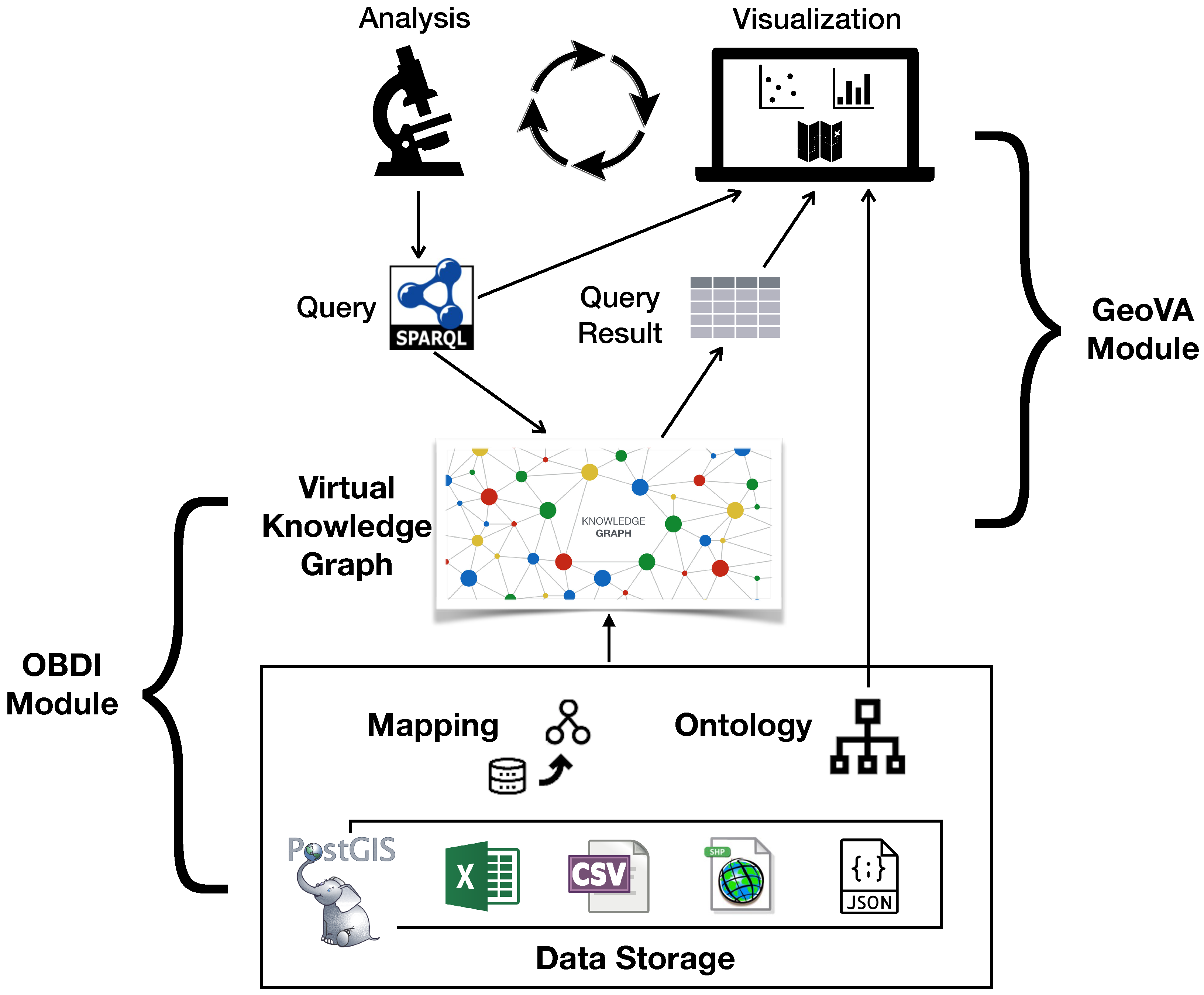
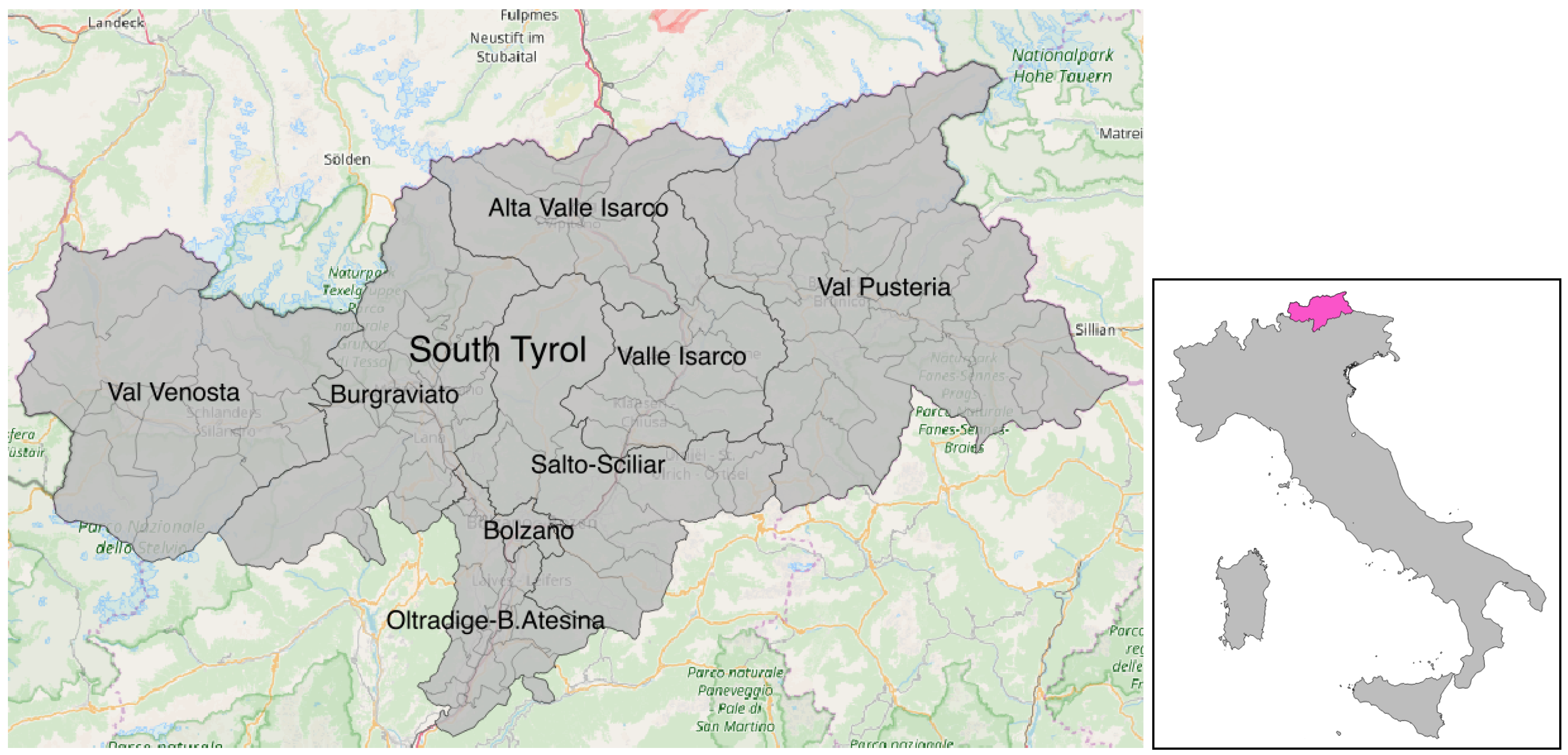

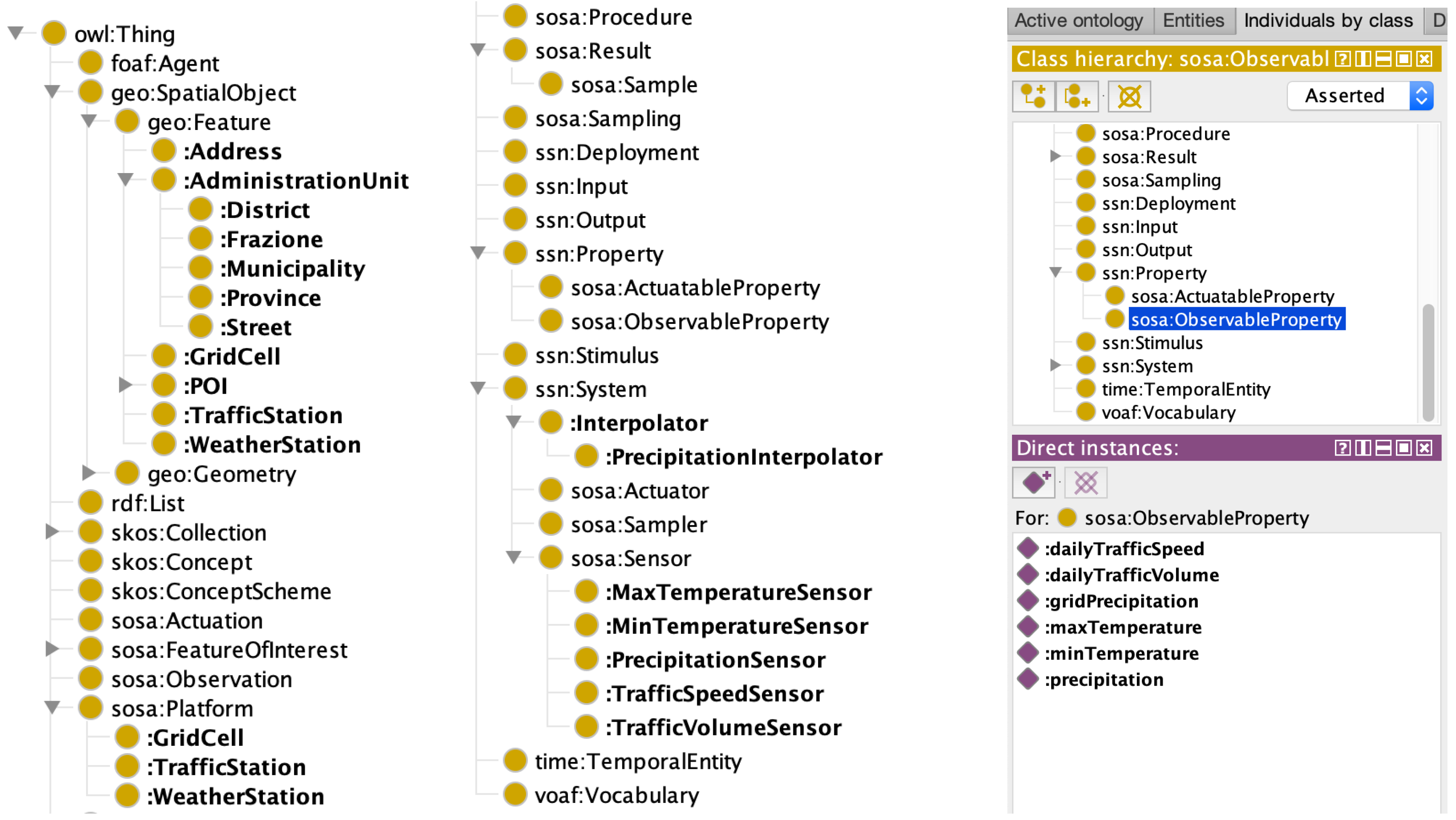





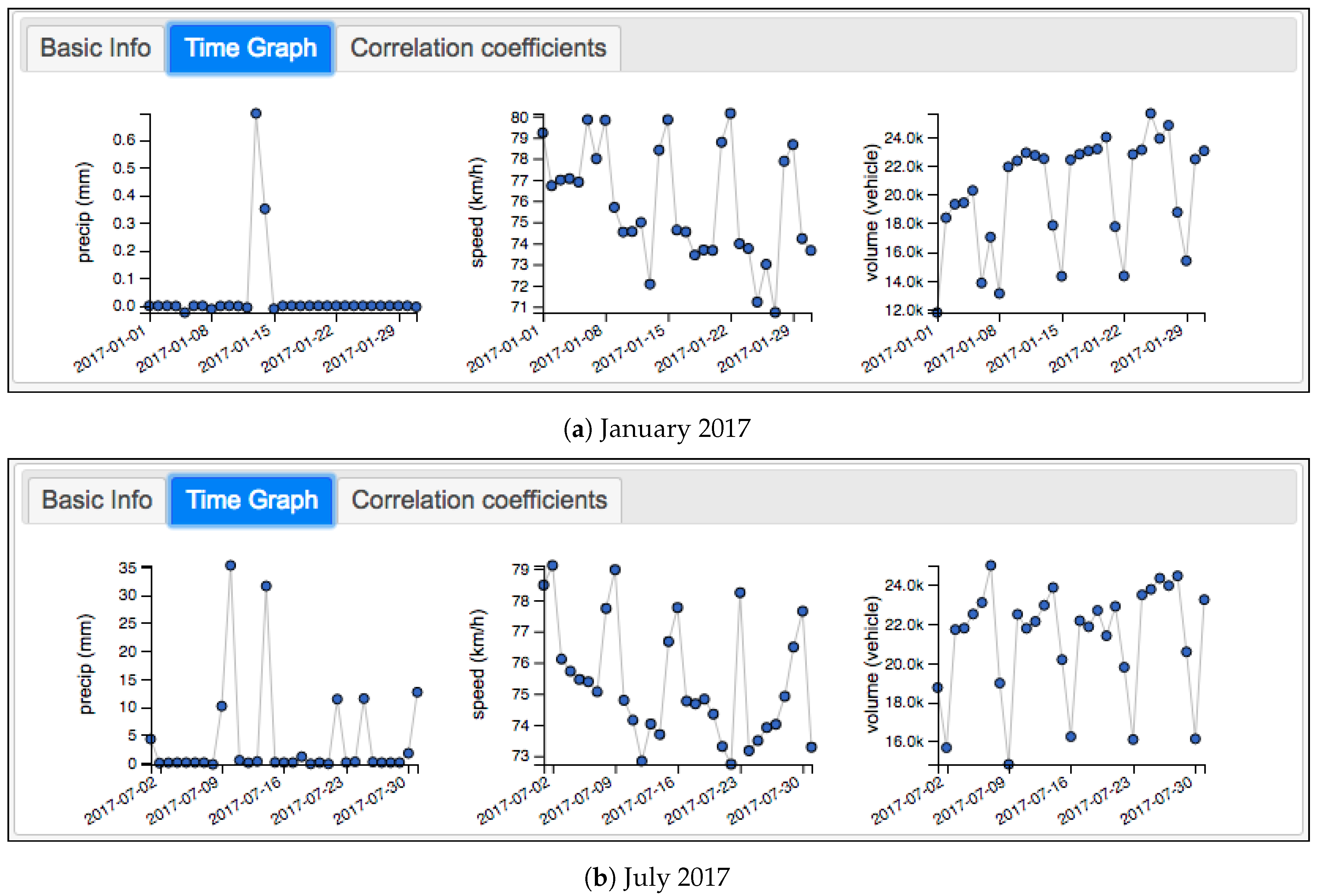

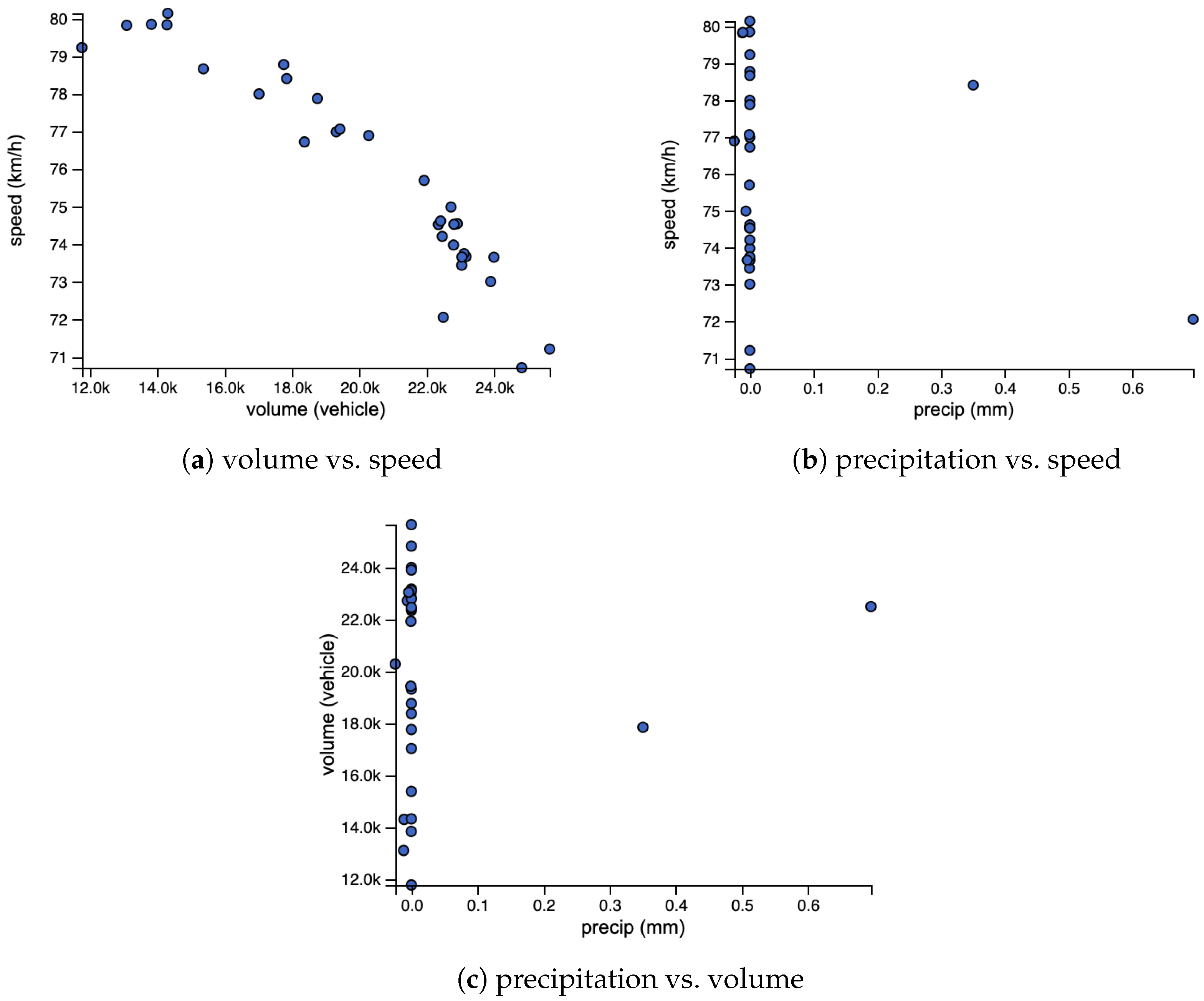
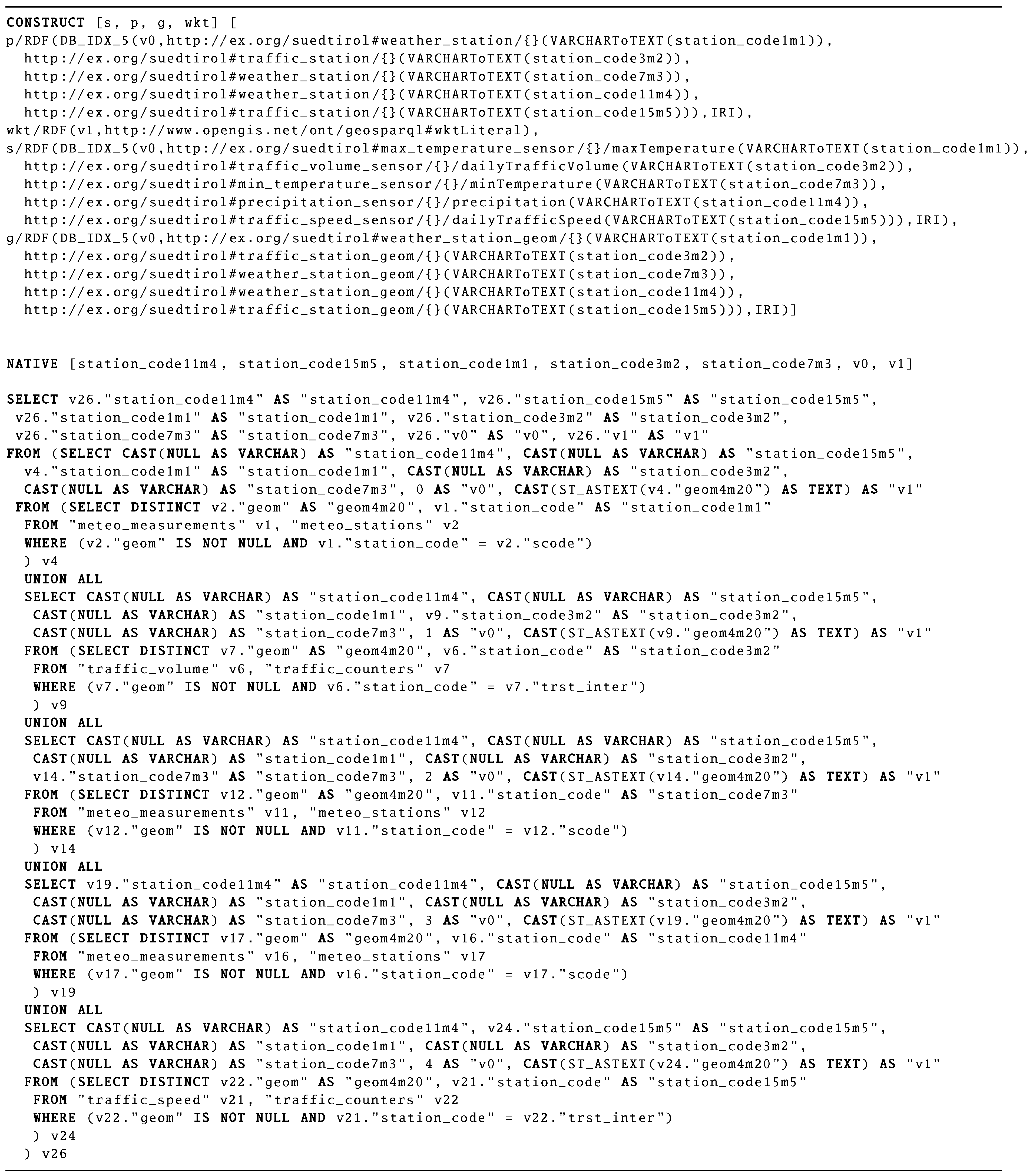
| Dataset | Description | Format | Spatial | Temporal | #Entries | Source |
|---|---|---|---|---|---|---|
| municipality | polygons, names (de/it), etc. | .shp | √ | - | 116 | ODP |
| meteo stations | code, name, location, etc. | .json | √ | - | 84 | ODP |
| meteo sensors | amounted station, sensor type (e.g., air temperature, precipitation) | .json | - | - | 584 | ODP |
| meteo measurements | 1981–2017, daily min-, max-temperature, precipitation | .xls | - | √ | 388,680 | ODP |
| traffic counters | code, name, location, etc. | .shp | √ | - | 75 | ODP |
| traffic volume | daily average traffic volume in 2017 | .xls | - | √ | 23,381 | ASTAT |
| traffic speed | daily average traffic speed in 2017 | .xls | - | √ | 23,950 | ASTAT |
| Mapping Assertion | Sample Data in the Database | Generated RDF Triples |
|---|---|---|
M_traffic_station_info:
<traffic_station /{trst_inter}> a : TrafficStation;
:hasID {trst_inter};
rdfs:label {trst_place}@it , {trst_pla00}@de;
sosa:hosts
<traffic_volume_sensor /{trst_inter}/ dailyTrafficVolume>,
<traffic_speed_sensor /{trst_inter}/ dailyTrafficSpeed>.
← SELECT trst_inter , trst_place , trst_pla00
FROM traffic_counters
| (3, ‘Pineta di Laives’, ‘Steinmannwald’) |
<traffic_station/3> a :TrafficStation ;
:hasID ‘3’ ;
rdfs:label "Pineta di Laives"@it , "Steinmannwald"@de ;
sosa:hosts
<traffic_volume_sensor/3/dailyTrafficVolume>,
<traffic_speed_sensor/3/dailyTrafficSpeed>.
|
M_traffic_station_geom :
<traffic_station/{trst_inter}> geo:defaultGeometry
<traffic_station_geom/{trst_inter}>.
<traffic_station_geom/{trst_inter}> a sf:Point;
geo:asWKT {wkt }^^geo:wktLiteral .
← SELECT trst_inter , ST_AsText (geom) AS wkt
FROM traffic_counters
|
(3,
‘POINT (680089.9
5146685.9)’)
| <traffic_station/3> geo:defaultGeometry <traffic_station_geom/3>. <traffic_station_geom/3> a sf:Point ; geo:asWKT "POINT (680089.9 5146685.9)"^^geo:wktLiteral. |
M_sensor_traffic_volume :
<traffic_volume_sensor/{station_code}/dailyTrafficVolume> a
:TrafficVolumeSensor;
sosa madeObservation
<obs_traffic_volume/{station_code}/{date}>.
← SELECT station_code , date
FROM traffic_volume
| (3, ‘2017-01-01’) | <traffic_volume_sensor/3/dailyTrafficVolume> a :TrafficVolumeSensor; sosa:madeObservation <obs_traffic_volume /3/2017-01-01>. |
M_observation_traffic_volume :
<obs_traffic_volume/{station_code}/{date}> a sosa:Observation;
sosa:observedProperty <dailyTrafficVolume> ;
sosa:hasSimpleResult {daily_volume};
sosa:resultTime {date}.
← SELECT station_code , date , daily_volume
FROM traffic_volume
| (3, ‘2017-01-01’ ,11771) | <obs_traffic_volume/3/2017-01-01> a sosa:Observation. sosa:observedProperty <dailyTrafficVolume>; sosa:hasSimpleResult 11771 ; sosa:resultTime "2017-01-01". |
© 2020 by the authors. Licensee MDPI, Basel, Switzerland. This article is an open access article distributed under the terms and conditions of the Creative Commons Attribution (CC BY) license (http://creativecommons.org/licenses/by/4.0/).
Share and Cite
Ding, L.; Xiao, G.; Calvanese, D.; Meng, L. A Framework Uniting Ontology-Based Geodata Integration and Geovisual Analytics. ISPRS Int. J. Geo-Inf. 2020, 9, 474. https://0-doi-org.brum.beds.ac.uk/10.3390/ijgi9080474
Ding L, Xiao G, Calvanese D, Meng L. A Framework Uniting Ontology-Based Geodata Integration and Geovisual Analytics. ISPRS International Journal of Geo-Information. 2020; 9(8):474. https://0-doi-org.brum.beds.ac.uk/10.3390/ijgi9080474
Chicago/Turabian StyleDing, Linfang, Guohui Xiao, Diego Calvanese, and Liqiu Meng. 2020. "A Framework Uniting Ontology-Based Geodata Integration and Geovisual Analytics" ISPRS International Journal of Geo-Information 9, no. 8: 474. https://0-doi-org.brum.beds.ac.uk/10.3390/ijgi9080474




